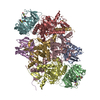+Search query
-Structure paper
| Title | Structural insights into the bacterial carbon-phosphorus lyase machinery. |
|---|---|
| Journal, issue, pages | Nature, Vol. 525, Issue 7567, Page 68-72, Year 2015 |
| Publish date | Sep 3, 2015 |
 Authors Authors | Paulina Seweryn / Lan Bich Van / Morten Kjeldgaard / Christopher J Russo / Lori A Passmore / Bjarne Hove-Jensen / Bjarne Jochimsen / Ditlev E Brodersen /   |
| PubMed Abstract | Phosphorus is required for all life and microorganisms can extract it from their environment through several metabolic pathways. When phosphate is in limited supply, some bacteria are able to use ...Phosphorus is required for all life and microorganisms can extract it from their environment through several metabolic pathways. When phosphate is in limited supply, some bacteria are able to use phosphonate compounds, which require specialized enzymatic machinery to break the stable carbon-phosphorus (C-P) bond. Despite its importance, the details of how this machinery catabolizes phosphonates remain unknown. Here we determine the crystal structure of the 240-kilodalton Escherichia coli C-P lyase core complex (PhnG-PhnH-PhnI-PhnJ; PhnGHIJ), and show that it is a two-fold symmetric hetero-octamer comprising an intertwined network of subunits with unexpected self-homologies. It contains two potential active sites that probably couple phosphonate compounds to ATP and subsequently hydrolyse the C-P bond. We map the binding site of PhnK on the complex using electron microscopy, and show that it binds to a conserved insertion domain of PhnJ. Our results provide a structural basis for understanding microbial phosphonate breakdown. |
 External links External links |  Nature / Nature /  PubMed:26280334 / PubMed:26280334 /  PubMed Central PubMed Central |
| Methods | EM (single particle) / X-ray diffraction |
| Resolution | 1.7 - 16.0 Å |
| Structure data |  EMDB-3033:  PDB-4xb6: |
| Chemicals |  ChemComp-SO4:  ChemComp-ZN:  ChemComp-HOH: |
| Source |
|
 Keywords Keywords | TRANSFERASE / protein complex |
 Movie
Movie Controller
Controller Structure viewers
Structure viewers About Yorodumi Papers
About Yorodumi Papers




